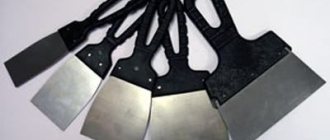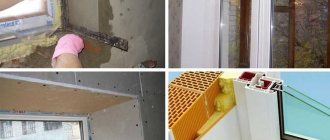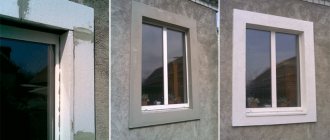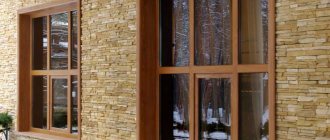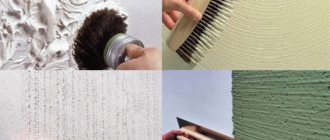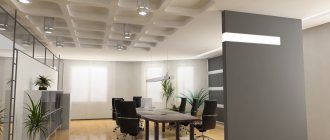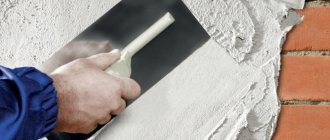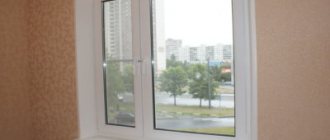Installation of window slopes is finishing work. Some owners opt for insulation, but most prefer to give the windows a beautiful look so that the entire interior is made in the same style, because well-designed double-glazed windows will add coziness and comfort, especially if we are talking about year-round living.
Slopes solve several important problems:
- provide protection for frames and openings from moisture;
- serve as an additional barrier to the cold, extending the service life of the structure;
- decorate the window and increase aesthetics.
Hence the conclusion: the elements must be durable, water-resistant and have a pleasant appearance.
Choice of window design
In a wooden structure, it will be possible to install both plastic and wooden windows. To decorate the appearance of such a source of natural light, you will need to make a high-quality finishing of the slopes. The choice of finishing for the slopes depends on what material the windows are made of. In a wooden house, the finishing of the slopes can be external or internal. To do this, they often use:
- Plastic.
- Wooden lining.
- Natural wood.
For external slopes, it would be better to opt for more practical finishing materials that do not absorb moisture. Only then can such slopes serve for a long period of time. In interior decoration, it is possible to use any finishing material, since the surface of the slopes will be protected from the effects of weather and climatic phenomena.
Plastic in finishing the slopes of a wooden house
For many years, finishing materials such as plastic have been used for external and internal work. It is very practical and durable. If there is a plastic window in a wooden house, then it would be best to make the slope out of plastic:
- Plastic panels for finishing work have a wide range of colors, which will allow you to choose the desired tone. As a rule, in a wooden house, plastic windows have an imitation of wood. Today, plastic panels have a large selection of colors that can also imitate wood covering.
- In addition to all this, plastic is considered a sealed material that is not capable of allowing air and moisture to pass through, which means that the tree will be fully protected from the effects of weather or climatic phenomena.
- Plastic panels are very easy to clean as they do not absorb any dirt. It will be enough to wash them with a damp cloth without using special detergents.
- Do not forget about the durability of such finishing material. The service life of plastic panels is almost unlimited. It can be replaced in case of breakdown or loss of presentation. If plastic panels have a fairly low cost, then they can lose color very quickly, which cannot be said about higher-class panels, which are mainly used for finishing slopes in a wooden house from the outside.
- Plastic is considered an environmentally friendly material, which means it will not pollute the environment. It is for this reason that finishing windows in a wooden house with plastic is possible even indoors (see Finishing windows with plastic - installation stages).
- Plastic panels are frost-resistant. This fact is very important for those regions that have a very low temperature threshold in winter. They are also not subject to mechanical and physical stress.
Advice. To ensure that the finishing of plastic windows in a wooden house with plastic is of higher quality, you need to carefully examine the surface of the finishing material. It should be smooth and not have any deformations. This is the only way the appearance of the slope will not be disturbed.
In the process of finishing the slopes in a wooden house, it will be possible to replace the window sill or install it. It can also be made of plastic, which will create the effect of integrity of the entire structure. In order to finish slopes in a wooden house with plastic panels, you will need to have:
- Plastic.
- External and internal corners.
- Screwdriver.
- Sealant.
- Construction stapler with staples, matching the color of the plastic panels.
Features of PVC and wood material
Finishing plastic windows in a wooden house with PVC slopes is a fairly popular option. This practical material will serve you for a long period of time; the plastic has an attractive appearance and is resistant to moisture.
Finishing slopes in a wooden house from the outside on the facade side will last for many years without losing its functions. The main advantages of plastic include the following:
- reliable protection of wood;
- resistance to temperature changes;
- variety of shades: from natural to bright;
- ease of care: without additional chemical cleaning agents, you can quickly remove dust and various types of dirt.
Plastic slopes reliably protect wood from moisture
Wooden materials have their advantages:
- attractive appearance;
- natural material that does not cause allergic reactions;
- durable, has a long service life, subject to proper installation and maintenance;
- the ability to paint the slope in any color based on the color of the interior or facade of the building.
Advantages of wooden slopes for a wooden house
Despite the positive characteristics of plastic, for many, the choice in favor of wood remains a priority. In addition to external aesthetics, installing wooden slopes has many positive aspects.
Reliable fixation and proper care provide wooden casing with strength and durability
Compared to plastic and other synthetic materials, such products are environmentally friendly and do not cause allergies. Wood has good soundproofing properties. Wooden slopes can be securely fixed, and if cared for correctly, they can last much longer than plastic .
Wooden slopes and window sills are suitable for finishing windows of any size, made of PVC or wood. Wooden products can harmoniously hide the shortcomings and errors in creating a window opening that may appear during the installation of windows.
Installation of window sills and slopes
The following materials can be used for the window sill:
An important point is also the vapor barrier layer inside and outside the opening. The installation of the double-glazed window itself involves fastening in the form of anchor plates.
An alternative method of attaching a wooden slope
In this case, a wooden frame is made, which is fixed to the window opening of the house using self-tapping screws.
- Cut the wood panels to the required sizes.
- Attach insulation to them, for example, strips of mineral wool.
- The top layer of insulation should be covered with plastic film, which is secured with double-sided tape.
- Fix the panels together: fasten them with self-tapping screws.
- Next comes the installation and fastening of the resulting frame structure in the window opening.
This method, like the first, will reliably block access of the external environment to the polyurethane foam. After finishing in this way, a plastic or wooden window in the house will be well protected and will retain its best characteristics for as long as possible.
There is a third option, which involves the use of wooden lining. Please note that before such finishing, battens are usually installed to hide uneven walls.
Slopes finished with clapboard are a good option for wooden buildings, but installation of sheathing may be required
Also, if necessary, you can make window slopes using one of the many modern natural wood-based materials. The procedure for carrying out work in this situation, compared to the first two methods, will not change significantly. In any case, it is advisable to insulate the window with foam or insulation to ensure maximum heat and moisture insulation.
Mounting options
There are two most popular options for installing wooden window slopes. Let's look at each of them in more detail.
On polyurethane foam
If this method of arranging slopes is chosen, then work can begin 12 hours after installation of the window block itself. This time will be required for the foam used to install the window to dry.
This method is perfect in cases where the window opening does not have significant defects and all edges of the opening are already finished (with cement or other rough materials).
Installation sequence:
- Before applying the mounting foam, it is recommended to slightly moisten the surface of the opening.
- Polyurethane foam is applied in a small layer to each element of wooden slopes.
- The side slopes should be positioned so that they support the top.
- Before the polymerization of the foam is completed, additional spacers must be installed.
- The most important thing when installing parts is maintaining the symmetry and straightness of all elements and the structure as a whole. If distortions are noticed, they must be eliminated immediately, before the foam hardens. Then it will no longer be possible to do this.
Important! All excess polyurethane foam that appears on the surface must be removed immediately after drying. The foam can be easily cut off with a utility knife.
On a frame made of bars
This option will be relevant in cases where the window opening has significant defects. A frame made of bars will make it possible not only to level the surface, but also to insulate the window.
It is recommended to make the frame from a mounting rail; it has the same thickness. All bars are installed in the same plane using a building level. The resulting voids must be filled with insulation. Only after this do they begin finishing.
You can attach the finished slopes to the bars using liquid nails. This substance hardens quickly, gives a strong connection, and nothing will be visible on the surface. There is another, less popular way - using lining fasteners.
Which slope finish should I choose?
Experts recommend using a slope made from the same types of wood that were used in the manufacture of the frame. Due to this, you will achieve the same color and pattern, because it is obvious that each type of wood has its own texture. If you combine several types of wood, the pattern will be different. Slopes can be up to 2.8 m long and 1 m wide. Their thickness is usually 12 and 15 cm.
Wooden panels are made from FSF plywood. This material is famous for its strength and reliability, it has a high level of wear resistance and resistance to moisture. Before installing the panels, a primer is applied to them, and a veneer mixture is applied to the base. Thanks to this, the slopes will hold stronger, and after this, the paint and varnish compositions will lie more evenly. To treat slopes, use a transparent or colored polyurethane-based varnish that lies flat on the wooden surface.
Experts recommend using slopes made of larch. This type of wood has high strength, is resistant to rot, does not lend itself to moisture and easily tolerates temperature changes. Another advantage of larch is its low cost, since trees of this species grow quickly.
Insulation of slopes
Often, window openings are not insulated with anything, but the voids are simply carefully filled with foam. However, it should be remembered that window openings are places in the house through which significant heat loss can occur. Polyurethane foam can dry out over time, which will lead to drafts. Therefore, additional insulation is used in these places.
The following are most often used as insulation for slopes:
- Styrofoam. This material is characterized by efficiency, durability, ease of installation, low flammability, excellent heat and sound insulation. For the best result, you should buy foam plastic with a thickness of 20 mm and a density of 30-35 kg/m3. This material is suitable for self-insulation.
- Mineral wool. It has the same advantages as the previous material, but is more expensive. The disadvantage of mineral wool is its high moisture absorption. Another disadvantage is that particles of the material can enter the air in the form of dust; it is important to take this into account when working and use protective equipment (respirators). For slopes they buy P-125 mineral wool with a density of 125 kg/m3 or PZh-175. The latter option is even more dense and rigid.
- Foamed polyethylene. This material will cost even more. In addition to the qualities inherent in previous insulation materials, polyethylene has excellent moisture resistance; this is especially true when insulating window slopes. When using this material, you will have to take care of sealing the joints in the slopes.
- Sandwich panels made of 2 or 3 layers. Its main advantages are low weight and high load resistance. The cost of sandwich panels, especially three-layer ones, is high. This material has two layers of plastic on the outside and foamed polystyrene on the inside.
Types of window slopes used in private housing construction
The choice of slopes, both external and internal, is largely determined by what kind of window structures are installed in a residential building.
Today, the greatest preference is given to PVC products, although many owners still choose wooden fillings. In any case, quite stringent requirements are imposed on slopes, which include not only an aesthetically pleasing design, but also the presence of such parameters as moisture resistance, strength, practicality in operation and, importantly, durability. Today, three types of slopes are used in private housing construction:
- Plastic. Their advantages are compatibility with PVC windows, practicality in use, simplicity and ease of installation. It is also necessary to note the low cost of the products;
- Wooden. It is also used quite often. The obvious advantages of such slopes include an aesthetically pleasing and natural appearance, natural use in buildings made of logs or timber, as well as excellent performance properties. The main disadvantage is the higher manufacturing price compared to plastic ones;
- Made from lining. In such a situation, only natural panels are used that provide a sufficient level of strength and reliability. Slopes of this type act as a kind of intermediate option between the two described above.
Any of the varieties described can be used as slopes for plastic windows in a wooden house. Obviously, when installing wooden fillings, installation of all three types of products in question is also possible. However, when using structural elements made from different materials, it is extremely important to carefully comply with all technological requirements.
Installation work
In order for the external and internal finishing of window slopes to be reliable, everything must be installed according to the rules. Before you begin the step-by-step installation of wooden or plastic window slopes, you should check the quality of the materials. The finished surface will be smooth and without cracks only if you install plastic or wood that has not been subject to deformation. Exclusively with this option, external slopes will provide reliable protection for windows and openings.
Plastic panels are secured around the perimeter using self-tapping screws
To begin installation work with your own hands, you will need the following materials and equipment: slope strips made of wood or PVC, corners, screwdriver, sealant, stapler, screws. Having acquired all the required building materials and tools in advance, you can begin to work. Such instructions will be relevant for creating both external and internal cladding.
External finishing of slopes with plastic panels in a wooden house is not difficult work - this is due to the clear and even cut of window openings in such buildings, which means they are quite smooth.
Sheathing work using screws is carried out in this way: the external and internal finishing of the window usually begins around the perimeter by securing a strip, called the starting strip; the panel is mounted using self-tapping screws, which are screwed into the bottom and top of the entire structure using a screwdriver; this is necessary for maximum camouflage capabilities.
Following these instructions, you can install the panels at the top of the opening. If the width of the slopes to be finished is significantly greater than the width of the panel itself, you need to use several panels, the fastening of which occurs using the tongue-and-groove technique.
After installation is complete, you need to move on to securing the corners. They are installed using a special installation adhesive or liquid nails.
Finishing with strips
The use of flashings is especially effective when finishing windows in wooden houses. The nuance of this work is that the external finishing of a plastic window should begin only after the external finishing is completed.
It is best to carry out this type of work in the dry season, when air humidity is normal.
When performing external work, it will be necessary to install flashing and flashings.
In addition to the ebb itself, we will need:
- an ordinary screwdriver, preferably compact;
- metal scissors;
- ruler or meter tape;
- construction pencil or felt-tip pen;
- square or level;
- screws suitable in length, self-tapping screws are possible. Usually no more than two centimeters long.
We determine the length of our ebb by measuring the width of the opening. Add five centimeters to each side. It is recommended to cut the ebbs strictly at an angle of 90 degrees, and carefully bend the edges down. After the work has been completed, we fix our ebb using screws or self-tapping screws. We fill the ebb areas and all cavities with polyurethane foam using a special gun.
At the very end of the work, we begin gluing the strip. The strip itself is a strip that covers the mounting foam from external environmental influences. Pay attention to the temperature! If it is below five degrees, then problems may arise during gluing, or they will arise in the future. It is recommended to carry out work in warm, dry weather.
Brief step-by-step instructions
- measure the height of the plastic window opening;
- cut strips of the required sizes;
- clean and sand, thoroughly dry the surface where the strips will be glued;
- We glue it gradually, tearing off a piece of the protective tape and gluing it.
Why do you need high-quality exterior window treatments?
High-quality exterior window treatments
This type of finishing comes down, first of all, to the construction of slopes, which perform the following functions: decorative and protective. According to experts, exterior decoration is many times more important and significant than similar interior decoration. The problem is that when installing plastic windows, it is common to use ordinary polyurethane foam, the durability of which is very weak and short-lived. Especially when it comes to outdoor work: such foam is sensitive to environmental influences, especially to ultraviolet rays emitted by the sun.
The main functions of external window decoration are as follows:
- protection from water and moisture, from the appearance of fungal infections such as mold;
- preservation of the properties of polyurethane foam and protection from external influences;
- a decorative function that is designed to please your eye and the eyes of others.
- Get to work!
Slopes made of wooden lining
In order to make not just a high-quality, but also an aesthetically attractive design for your plastic windows, you should select a material that would be combined with the style and appearance of the entire house (find out here how to decorate the slopes on the windows).
In a wooden house, slopes created by wooden lining will look most harmonious.
This design should also be chosen because:
- Today there are a huge number of options for colors and sizes of lining that will decorate a building of any color and an opening of any size;
- Lining is an environmentally friendly material, which means it is absolutely safe for you and your loved ones;
- The lining is distinguished by excellent strength and durability characteristics, which will allow it to serve for a long time without losing its presentable appearance.
Advice. If the lining is used for external work, after completion it should be coated with an additional layer of varnish. Then the surface will not be susceptible to pollutants and will not absorb moisture.
Lining in the design of a wooden house
How to choose the right finishing element
The functions of a window sill are known, but not everyone knows why slopes on windows in a wooden house are needed. Slopes in a wooden house not only add completeness to the interior, but also provide a kind of protection for the materials used to install the plastic window :
- protect window frames and openings from water ingress;
- help cover the mounting foam, prolonging its service life for as long as possible;
- visually improve the appearance of the window.
Slopes prevent moisture from entering the window opening and frame.
Based on the type of window that will be installed (metal-plastic or wood), it is necessary to consider various methods for creating window slopes. There is a huge range of products on sale that will not only effectively protect materials, but also decorate the facade and the inside of the room. Materials for installing slopes must have several basic characteristics: moisture resistance, strength, practicality, long service life, ease of installation and dismantling. To install the slopes, you can hire specialists or make and install slopes on a wooden house with your own hands.
In a log house or timber structure, a plastic slope, as well as cladding inside and outside with wooden panels, will look harmonious. The most popular options for a log house:
- plastic;
- lining made of natural panels;
- tree.
The most practical material for constructing slopes is plastic.
Despite the use of a wide variety of finishing options, when choosing plastic windows in a wooden house, it is best to create the finishing of the façade window opening using practical materials that do not absorb atmospheric moisture. In the best case, PVC window slopes are recommended to be installed from plastic . In a house made of timber, you can make slopes inside yourself and choose the material based on your own taste.
How to properly cover a window with clapboard?
As mentioned above, finishing windows with clapboard should start directly from the frame. Depending on the type of shalevka, the method of fastening is selected. The most common option is special finishing nails, which after installation will not stand out against the background of the panels, as can be seen in the photo.
If you use an American shalevka, when installing it, you must remember that the panels are mounted with a slight overlap, which allows you to protect the joints from the influence of various external factors.
When all the panels are in place, completely covering the slopes, you can begin decorating. It includes the installation of special corners made of appropriate material. Which will cover all joints and cracks. You can use self-tapping screws as fasteners, or attach the corners with regular glue. It is recommended to choose decorative corners in such a way that they complement the finishing decorative elements used in wall decoration.
All work can be done with your own hands, thanks to which you can avoid additional financial costs for paying for the services of qualified specialists.
Installation on wooden blocks
If the slopes are purchased with a window block, installation is simplified. Grooves are cut into the frames. They are installed the day after the window is installed. The necessary measurements are taken and the boards are cut to length.
Wooden ends are treated with a fine file or sandpaper. If the base of the opening is wooden, holes are drilled in the panels, inserted into the grooves (installation begins from the top panel), pressed tightly, and screwed with self-tapping screws.
When the frames and slopes are not included in the kit, the ends are adjusted. The correct fit is checked with a square. Next, the procedure is the same as in the previous version.
Manufacturing of casing (plugs)
Embedding block
The lower part of the window opening casing can serve as a finishing window sill. Its appearance can be customized to suit your taste. For example, move the window sill inside the room and expand the protruding part to the sides. This is called “with ears.”
In another case, if the window has a plastic window sill, the lower part of the window casing is made thinner than the other parts. This way it retains its function and does not interfere.
Bottom with ears = excellent wooden window sill
Casing without threshold on internal doorways. We suggest you familiarize yourself with How to fill the floor in a bathhouse with a slope under the drain with your own hands?
This is where the differences between window and door frames end. Their side parts and top are the same.
Simple tools you will need are a hammer, a chisel, a construction level, a hacksaw, a pencil or marker, a ruler, and a corner. Power tools include a chain saw or circular saw, an electric planer, and a hand router. The help of one or two friends will not be superfluous.
In a timber house we will make a T-frame, as it is easier to make with our own hands. Here you can do without a router, just use one hand-held circular saw, which you can rent.
The final result of the work.
For the top we take a beam 150 x 50 mm.
Windowsill. With a wind lock made of 150x90 mm timber and without a wind lock made of 150x50 mm timber.
Longitudinal cuts are made with a circular saw. If the cutting depth is not enough, carefully cut out the remaining wood with a chisel. We also select the groove for the wind lock using a chisel or a router.
And this is what a drawing of the sides of a classic casing deck looks like. The top and window sill are marked in the same way as the T-view.
Drawing of the side parts of the P-casing.
The technology for installing a pigtail in a timber house is as follows:
- We mark and cut out openings
- We mark a groove at the ends of the cut openings. Let's choose it. Or we form a spike if you chose a P casing.
- We impregnate the openings and the adjacent part of the casing with an antiseptic, for example Veres Base
- We insulate the opening with jute tape
- We install the bottom part, then the sides and finish by installing the top
- Checking the geometry
- We fill the free space above the tops tightly with jute
It seems simple, but as usual, the devil is in the details. I’ll try to show the process of installing casing in a house made of 150x150 mm timber. If it is unclear, ask in the comments.
When marking openings, remember the golden rule “measure twice, cut once.”
Slowly and carefully form a tenon on the side walls of the opening.
Use a building level. The window sill must be strictly horizontal, the sides must be vertical.
First, we insulate the lower part and install the window sill, then we insulate the remaining perimeter and install the sides. We close the casing by installing the top.
We coat the locks with wood sealant. No self-tapping screws!
At the final stage, we stuff the protruding jute into the seams. We also tightly plug the space above the top with it.
Let's check the geometry again. Profit!
The result of the work.
In the video, the house is not entirely made of timber. It is a fire monitor, but also with smooth walls. All stages of casing installation were well filmed. A bonus is the visual installation of plastic windows and doors.
Let's take as an example a 1.4 by 1.2 meter window in a house made of 150x150 profiled timber. We will calculate the width and height of the opening for a P-casing with a thickness of 90 mm. The wooden window sill is the lower part of the frame.
Calculation using the example of a window 1400 x 1200 mm.
- window width 1400 mm, window height 1200 mm
- thickness of side panels - 90 mm, top and window sill - 60 mm
- depth of the selected quarter for the frame - 25 mm
- drank above the tip - 70 mm
By the way! It will be interesting to know: How to paint OSB slabs for exterior decoration on the facade of a house
The width of the opening = the width of the window, two thicknesses of the casing - two quarter depths of 5 mm for the gap between the casing and the wall on each side and 10 mm for the gap between the casing and the frame, also on each side.
1400 90 90 30–50 = 1560 mm
The height of the opening = the height of the window, the thickness of the window sill, the thickness of the top 25 mm for gaps - two quarter depths, the gap above the top.
1200 90 90 25–40 70 = 1435 mm
The principle, I think, is clear. If anything, ask in the comments.
What should you consider when choosing lining?
In order for a window covered with clapboard to last for a very long time, special attention should be paid to the choice of material. First of all, we are talking about the variety. It is generally classified into four main categories. “Extra” is rightfully considered the best and highest quality. It has a perfectly smooth structure and surface. Grade “A” is slightly worse in terms of aesthetic parameters, as it allows the presence of one small knot on each panel. If you pay attention to grades “B” and “C”, then their aesthetic parameters will be even lower.
As for the quality of the shalevka, it directly affects the durability of use. For example, if the wood does not have a special protective impregnation, or its processing technology has been violated, then the surface will very quickly begin to darken and will require additional time and effort to restore its original appearance. At the same time, it is worth considering that any wood will begin to darken over time.
What is casing?
It is known that a fresh log house of a wooden house “shrinks”: it becomes lower, decreases in size and height:
Unlike apartments and stone houses, the installation of windows and doors in wooden houses must be done in casing.
Here is a schematic drawing of our casing with the installation of a foundation block:
About shrinkage
How long does it take for a log house to “shrink”?
OK. This depends on many factors:
- vertical load on the frame: roof, interfloor ceilings
- ambient temperature and humidity
- presence or absence of heating in the log house
It is believed that log houses made of wood with natural moisture actively “shrink” in the first year and a half. Then about another year, after the start of regular heating and the start of operation of the house. And just a little, the house will shrink over the next 3-4 years.
By the way! It will be interesting to know: Laying artificial stone with your own hands: the process from A to Z
